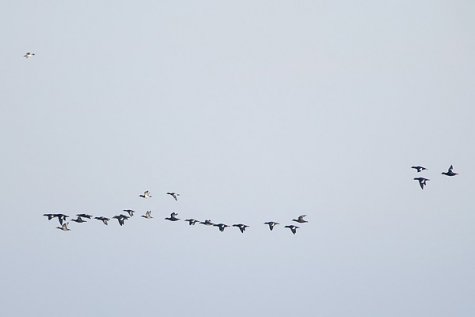Velvet scoters in large numbers in places
Photo: Arne Ader
Translation: Liis
Velvet scoters
Velvet scoter Tõmmuvaeras Melanitta fusca
In calm weather quite a number of flocks of swimming velvet scoters can be seen from the seashore, as well as those who fly in a wavy flight above shallow waters away from the shore. They are nesters and passing migrants as well as winterers in Estonia, meaning that we can meet them the year round even in a frozen sea in ice-free spots. Migrants also pass the Lake Peipsi water basin.
Velvet scoters are late nesters and this year’s young birds have fledged only in early September. In size these diving ducks are comparable to the familiar mallards. There are no changes in the plumage of velvet scoters, the eclipse or resting and alternate or breeding plumages are similar. In common for ducks the plumages of males and females differ. The male’s is pitch black, some little colour on the beak – yellowish red, with a small black beak knob. There is a contrasting white dot at the eye. The female’s plumage is modestly blackish brown. For both a white wing patch (speculum) is visible in flight. The weight varies from a kilo to nearly a couple of kilos.
Up to a couple of hundred thousand birds can be staying for winter in Estonia. As suits diving ducks they feed on mussels, crustaceans and also on Polychaeta worms.









